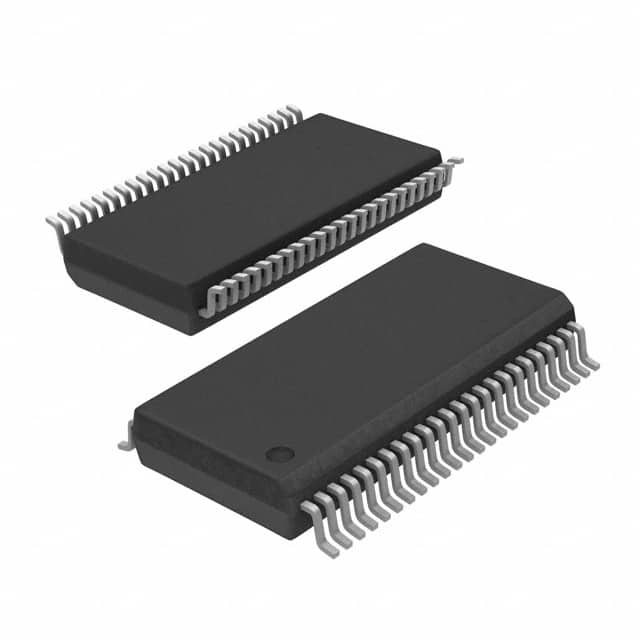SN74LVT16245ADLR
Product Overview
- Category: Integrated Circuit (IC)
- Use: Level Shifter and Bus Transceiver
- Characteristics: High-speed, low-voltage, 16-bit bidirectional transceiver
- Package: TSSOP (Thin Shrink Small Outline Package)
- Essence: Transfers data between two bidirectional buses with different voltage levels
- Packaging/Quantity: Tape and Reel, 2500 units per reel
Specifications
- Logic Family: LVT (Low-Voltage TTL)
- Number of Bits: 16
- Input Voltage Range: 1.65V to 3.6V
- Output Voltage Range: 1.65V to 3.6V
- Maximum Data Rate: 400Mbps
- Operating Temperature Range: -40°C to +85°C
- Supply Voltage: 2.3V to 3.6V
- Supply Current: 10mA (typical)
Detailed Pin Configuration
The SN74LVT16245ADLR has a total of 48 pins, which are divided into four groups:
- Group A (pins 1-12): Port A Inputs/Outputs
- Group B (pins 13-24): Port B Inputs/Outputs
- Group C (pins 25-36): Control Inputs
- Group D (pins 37-48): Power and Ground Pins
For the detailed pin configuration diagram, please refer to the datasheet provided by the manufacturer.
Functional Features
- Bidirectional Data Transfer: Allows data transmission in both directions between two buses with different voltage levels.
- Voltage Translation: Converts signals from one voltage level to another, ensuring compatibility between different logic families.
- Direction Control: Provides control inputs to determine the direction of data flow.
- Output Enable: Allows the user to disable the outputs when not needed, reducing power consumption.
Advantages and Disadvantages
Advantages: - High-speed data transfer - Low-voltage operation - Bidirectional functionality - Compact TSSOP package - Wide operating temperature range
Disadvantages: - Limited number of bits (16) - Requires external control signals for direction control
Working Principles
The SN74LVT16245ADLR is designed to facilitate the bidirectional transfer of data between two buses with different voltage levels. It utilizes level shifting circuitry to convert the logic levels of incoming signals from one voltage domain to another. The direction of data flow is controlled by the control inputs provided. When enabled, the IC allows data to pass from Port A to Port B or vice versa.
Detailed Application Field Plans
The SN74LVT16245ADLR finds applications in various fields where level shifting and bus transceiver functions are required. Some potential application areas include:
- Microcontroller Interfacing: Facilitating communication between microcontrollers operating at different voltage levels.
- Communication Systems: Enabling data exchange between devices with varying voltage requirements, such as UART, SPI, or I2C interfaces.
- Industrial Automation: Connecting sensors and actuators operating at different voltage levels to a central controller.
- Automotive Electronics: Integrating different subsystems within a vehicle that operate at different voltage levels.
- Consumer Electronics: Supporting data transfer between components like displays, memory modules, and processors.
Detailed and Complete Alternative Models
- SN74LVC16245A: Similar to SN74LVT16245ADLR but operates at a lower voltage range (1.65V to 3.6V).
- SN74LVTH16245A: Offers higher speed and lower power consumption compared to SN74LVT16245ADLR.
- SN74AVC16245: Provides voltage translation capability with a wider operating voltage range (1.2V to 3.6V).
These alternative models offer similar functionality but may have different specifications and characteristics. It is recommended to consult the respective datasheets for detailed information.
Word count: 540 words
Senaraikan 10 soalan dan jawapan biasa yang berkaitan dengan aplikasi SN74LVT16245ADLR dalam penyelesaian teknikal
Sure! Here are 10 common questions and answers related to the application of SN74LVT16245ADLR in technical solutions:
Q: What is SN74LVT16245ADLR? A: SN74LVT16245ADLR is a 16-bit bus transceiver with 3-state outputs, commonly used for bidirectional data transfer between different voltage levels.
Q: What is the operating voltage range of SN74LVT16245ADLR? A: The operating voltage range of SN74LVT16245ADLR is typically between 2.7V and 3.6V.
Q: Can SN74LVT16245ADLR be used for level shifting between different voltage domains? A: Yes, SN74LVT16245ADLR is specifically designed for level shifting applications, allowing bidirectional data transfer between different voltage levels.
Q: What is the maximum data transfer rate supported by SN74LVT16245ADLR? A: SN74LVT16245ADLR supports a maximum data transfer rate of up to 200 MHz.
Q: How many channels does SN74LVT16245ADLR have? A: SN74LVT16245ADLR has 16 bidirectional channels, allowing for simultaneous data transfer on each channel.
Q: Does SN74LVT16245ADLR have built-in ESD protection? A: Yes, SN74LVT16245ADLR has built-in ESD protection, ensuring robustness against electrostatic discharge events.
Q: Can SN74LVT16245ADLR be used in both parallel and serial communication systems? A: Yes, SN74LVT16245ADLR can be used in both parallel and serial communication systems, depending on the application requirements.
Q: What is the power supply current consumption of SN74LVT16245ADLR? A: The power supply current consumption of SN74LVT16245ADLR varies depending on the operating conditions, but it typically ranges from a few milliamperes to tens of milliamperes.
Q: Can SN74LVT16245ADLR be used in high-speed data transmission applications? A: Yes, SN74LVT16245ADLR can be used in high-speed data transmission applications, thanks to its fast switching speed and low propagation delay.
Q: Are there any specific layout considerations for using SN74LVT16245ADLR? A: Yes, it is recommended to follow the layout guidelines provided in the datasheet to ensure proper signal integrity and minimize noise coupling between channels.
Please note that these answers are general and may vary depending on the specific application and design requirements. It is always recommended to refer to the datasheet and consult with the manufacturer for detailed information.


